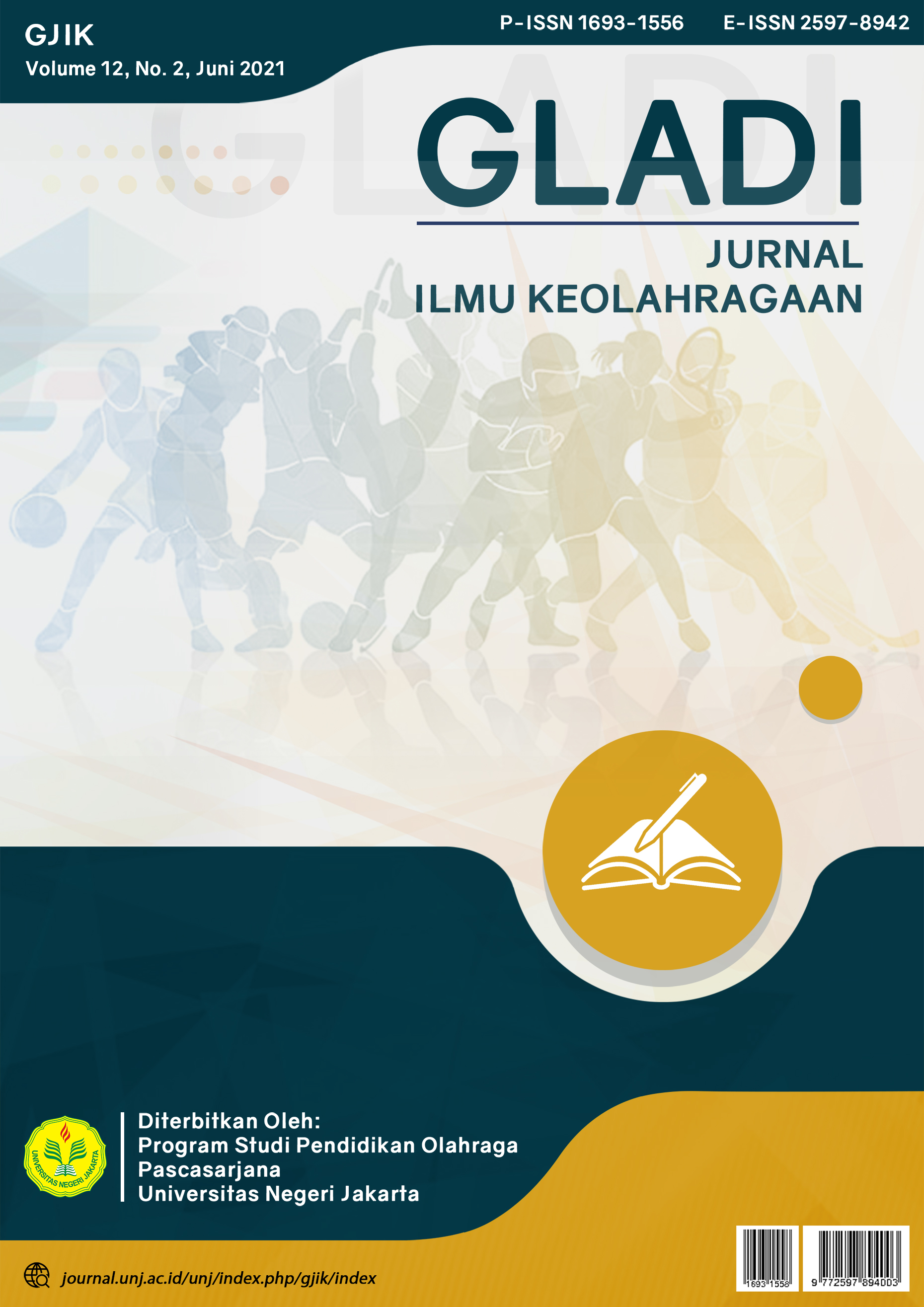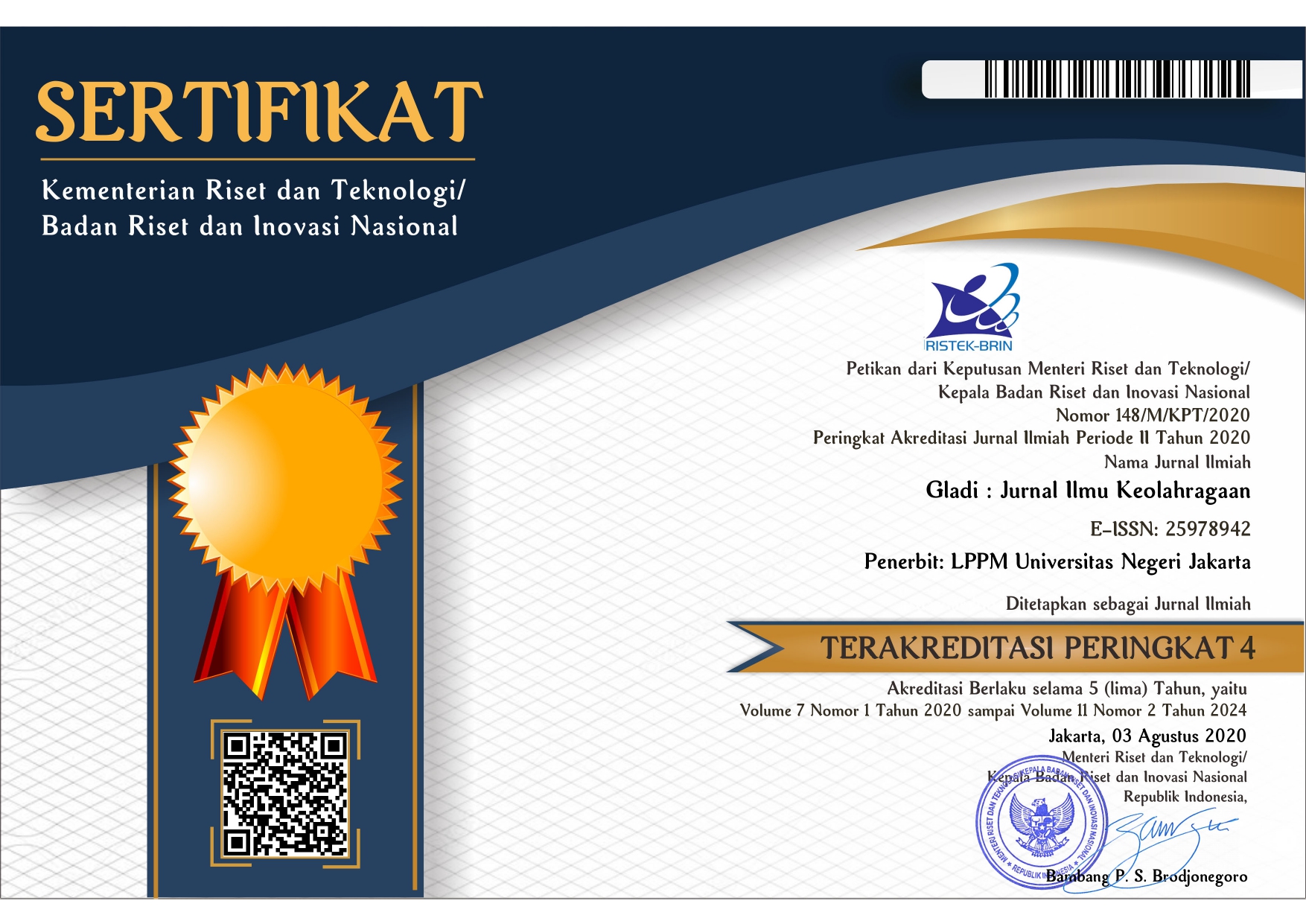THE PERSPECTIVE OF CLINICAL CLERKSHIP STUDENTS ON HEALTH PROTOCOLS DURING THE COVID-19 PANDEMIC ON DAILY EXERCISE ACTIVITIES
DOI:
https://doi.org/10.21009/GJIK.122.11Keywords:
Clinical Clerkship Student, Health Protocol, COVID-19 Pandemic, Sport, Daily Exercise activityAbstract
Physical exercise is essential to maintain human health. However, everybody has to apply the health protocols to prevent COVID-19 transmission during the pandemic. There is no exception; it is also applied for Clinical Clerkship Students who undergo the learning process at the Teaching Hospital. Unfortunately, no research provides a perspective on health protocol during the COVID-19 pandemic on daily exercise activities. This study aims to research the sports activities of Clinical Clerkship Students, measure knowledge about distance when exercising according to the protocol from the Ministry of Health, and describe their opinion regarding health protocols. This research conducted a mixed-method experiment that studies twenty-eight Clinical Clerkship Students. The type of sport and its frequency were evaluated using the International Physical Activity Questionnaire (IPAQ) short form. The enhancement of participants’ knowledge after watching the video and sport activity were studied descriptive quantitatively. Meanwhile, their opinion on the health protocol was analyzed qualitatively. The participants' Physical Activity Categories were 25% low, 50% moderate, and 25% high. The results showed that low and high IPAQ Catagories have a higher video post-test score, but there was no correlation. More than 75% of the students understand the contents of health protocols during exercise. We conclude that half of Clinical Clerkship Students have a moderate physical activity category and know about distance when exercising through educational videos and believe that maintaining health during a pandemic by exercising is necessary as long as they adhere to health protocols.
Downloads
References
Acosta, MM., Denham, AR 2018, ‘Simulating Oppression: Digital Gaming, Race and the Education of African American Children’, Urban Rev, vol. 50, pp. 345–362.
Bontempi, G, Birattari, M, & Bersini, H 2010, ‘Lazy learning for modeling and control design’, International Journal of Control, vol. 72, pp. 643-658.
Canto, B, Coll, C & Sanchez, E 2008, ‘Positive solutions of a discrete-time descriptor system’, International Journal of Systems Science, vol. 39, no. 1, pp. 81-8.
Engwerda, Jacob & Salmah, Y 2009, ‘The open-loop linear quadratic differential game for index one descriptor systems’, Automatica, vol. 45, pp. 585-92.
Engwerda, JC, Salmah, Y & Wijayanti, IE 2009, ‘The Open-Loop Discounted Linear Quadratic Differential Game for Regular Higher Order Index Descriptor Systems’, Center Discussion Paper, Operations research, Tilburg vol. 2009, no. 1.
Flanigan, A & Babchuk, W 2015, ‘Social media as academic quicksand: A phenomenological study of student experiences in and out of the classroom’, Learning and Individual Differences, vol. 44, no. 10, 1016/j.lindif.2015.11.003.
Haberman, R 1998, ‘Mathematical Models Mechanical Vibrations, Populations Dynamics, and Traffic Flow’, Prentice-Hall, USA.
Hu, Z, Tu, X 2015, ‘A new discrete economic model involving generalized fractal derivative’, Adv Differ Equ, vol. 65.
Kessels, U, & Heyder, A 2020, “Not stupid, but lazy? Psychological benefits of disruptive classroom behavior from an attributional perspective”, Soc Psychol Educ vol. 23, pp. 583–613.
Kordonis, I & Papavassilopoulos, GP 2014, ‘On Stability and LQ Control of MJLS With a Markov Chain With General State Space’, IEEE Transactions on Automatic Control, vol. 59, no. 2, pp. 535-40.
Liu, D, Yan, P, & Wei, Q 2014, ‘Data-based analysis of discrete-time linear systems in noisy environment: Controllability and observability’, Information Sciences, vol. 288, pp. 314–329.
Musthofa, MW, Salmah, Engwerda, J et al. 2016, ‘Robust Optimal Control Design Using a Differential Game Approach for Open-Loop Linear Quadratic Descriptor Systems’, J Optim Theory Appl, vol. 168, pp. 1046–1064.
Ogata, K 1995, ‘Discrete-Time Control System, 2nd ed’, Prentice-Hall, USA.
Pagalay, U 2009, ‘Mathematical Modelling, Aplikasi pada Kedokteran, Imunologi, Biologi, Ekonomi, dam Perikanan’, UIN-Malang Press, Malang.
Rachim, DKN, Salmah & Solekhudin, I 2017, ‘Link transmission model involving multi class vehicle’, 2017 5th International Conference on Instrumentation, Control, and Automation (ICA), Yogyakarta, pp. 158-62.
Raut, V & Patil, P 2016, ‘Use of Social Media in Educatrion: Positive and Negative’, International Journal on on Recent and Innovation Trends in Computing and Communication, vol. 4, pp. 281-85.
Sari, DR et al. 2019, ‘Analysis of the Factors Causing Lazy Students to Study Using the ELECTRE II Algorithm’, IOP Conf. Series: Journal of Physics: Conf. Series, vol. 1255, no. 012007.
Siddiqui, S & Singh, T 2016, ‘Social Media its Impact with Positive and Negative Aspects’, International Journal of Computer Aplications Technology Research, vol. 5, pp. 71-75.







